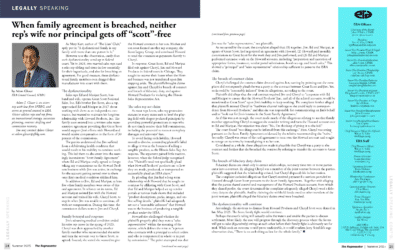Question: With the recent stock market decline, does it make sense for me to sell stocks that have decreased in value to create losses for tax purposes and then buy back the same positions?
Answer: If you sell a security at a loss and you in turn repurchase the same position within thirty days after the date of the sale, you cannot report a loss for tax purposes. The same holds true if you purchase a security not more than thirty days prior to the date you sell the same security at a loss. In either case, the amount of your nondeductible loss is added to the purchase price or tax basis of the new position that you have acquired. Effectively, the loss is postponed and will be deductible when the new position is sold or, if a gain results, the non-deductible loss will offset some or all of the gain when the stock is sold.
These so-called wash sale rules are designed to prevent taxpayers from claiming what the law deems artificial losses. There is no comparable rule allowing taxpayers to avoid gains if they sell appreciated stock positions and immediately repurchase the same positions. Of course, it would be the rare circumstance where a taxpayer voluntarily chooses to accelerate taxation on a security sale.
An obvious planning opportunity is to purchase the security you wish to sell more than thirty days before or more than thirty days after you sell the stock at a loss. If you have a feeling that the position will not recover for some time, you can sell the stock and create a deductible loss so long as you wait more than thirty days before repurchasing the same position. Alternatively, if you think the stock will rise quickly, you can purchase the same position today and wait more than thirty days before you sell the existing position in which case the wash sale rules will similarly not apply. In the latter case, you will have protected yourself from missing out on any appreciation that may have occurred had you waited more than thirty days before reinvesting.
Another opportunity is to sell the depreciated stock and purchase a different stock in the same industry. If, for example, you own stock in General Motors which has decreased in value and want to take a loss for tax purposes, you cannot sell the General Motors stock and report the loss if you repurchase General Motors stock within thirty days before or after the date the stock is sold. You can, however, sell your General Motors stock and create a tax loss if you purchase stock in another automobile company like Ford Motor Company. A purchase and sale of different stocks in the same industry may be helpful in avoiding the wash sale rule, particularly if stocks in that industry tend to rise and fall at the same time.
Suppose you sell a stock at a loss and your spouse, not you, acquires the same stock within thirty days of the sale. Will the wash sale rules apply? The law regarding related parties is somewhat unclear. There is precedent for combining the transactions of a married couple and applying the wash sale rules in this context. While you could be inviting an IRS challenge if you proceed in this manner, you may be able to prevail if you can establish that you and your spouse made independent decisions to purchase and sell the same security. If you choose to embark on this somewhat risky strategy, a better approach would be to have a more distant relative buy or sell the position, although there is no certainty that the IRS will respect this transaction.
If you are creating a loss for tax purposes, you should first determine if you will be able to deduct the loss. Capital losses are only deductible to the extent of capital gains and up to only $3,000 of ordinary income; any unused capital loss can be carried forward indefinitely for deduction in future years. A large capital loss, by itself, will not do you any good for tax purposes if you do not have capital gains for the loss to offset. In the right circumstances, however, proper timing of purchases and sales can provide a meaningful tax savings.
The Tax Corner addresses various tax, estate, asset protection and other business matters. Should you have any questions regarding the subject matter or if you have questions you want answered, you may contact Bruce at (312) 648-2300 or send an e-mail to Bruce Bell.



